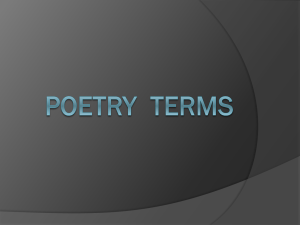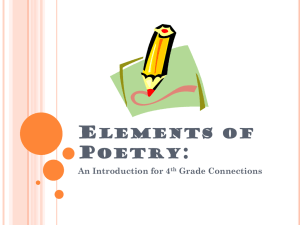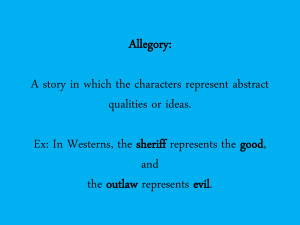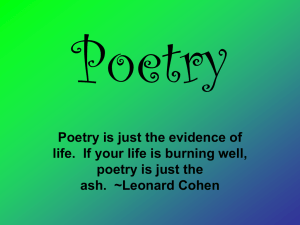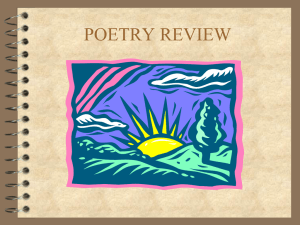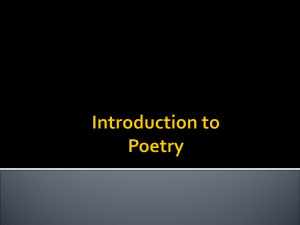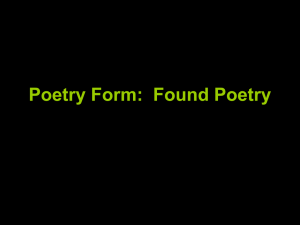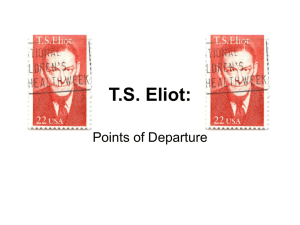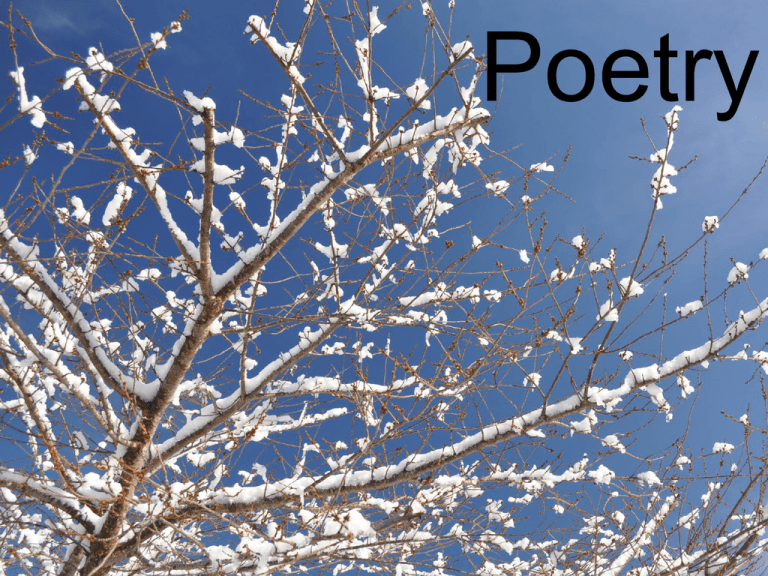
Poetry
Poetry Unit
• Be able to respond to poetry based on your
experiences and knowledge.
• Be able to read & interpret themes, images, and
devices used in poetry.
• Analyze and interpret poetry in written and spoken
forms.
• Know & use poetry terminology, types of poems,
and features of poetry.
• Connect poetry to human experience.
• Be able to use reader response and literary
analysis techniques.
What is poetry?
• Poetry rebels against your definitions… it is but it
isn’t, it can be but it doesn’t need to be, it might but
it doesn’t always.
• Poetry can’t by pinned down by your logic or need
to know it- poetry just is.
• Poetry doesn’t want to be shackled by your
limitations or told who to be. Poetry just is.
• Nobody sits around reading poetry just for fun
(well, some people do, but…) poetry smacks you in
the face with an epiphany when you least expect it.
That said…
• Poetry tends to be about the economy of languageusing words, carefully, well, chiselling words out of
stone cold marble into something beautiful.
• Pithy statements, carefully crafted images, and
word play are more common in poetry.
• Poetry tends to be more about story and emotion
than cold hard logic.
• Poetry tends to “spill out” and deal with emotion,
intense human experiences, or insights into what it
means to be human.
• There is a poem for everyone. You just have to
find it.
Do not do this to poetry:
• I hate you poetry! You mean nothing to me!
• I refuse to accept you for who you are poetry… you
must change into what I want you to be.
• It’s what I think so there is no right or wrong
answer (well, yes… but there is weak or faulty
interpretation that doesn’t take into account the
text, poet’s intent, devices, or poem…)
• Vivisection- dissecting poetry like a biology
experiment while it’s alive and breathing, ripping it
apart so much that you can’t put it back together to
make sense of what it is.
Big ideas
• Take a moment. Think back on the last few slides.
Review. Write yourself a little note about how you
and poetry can be friends.
QuickTime™ and a
decompressor
are needed to see this picture.
Different formats of poems
• Poetry tends to be divided into two groups: those with rules
and those without rules.
• How can you tell?
• How many lines are in the poem? Some poems have rules
about the number of lines- sonnets have only 14 lines (no
more, no less).
• How many syllables are in each line? Is there a pattern?
Some poems must have a regular pattern of meter or number
of syllables per line (blank verse must have 10 stressed /
unstressed syllables per line).
• What is the rhyme scheme or pattern of end rhyme? Some
poems have rules about rhyme (limerick = aabba)
• What is the topic or purpose of the poem? Does the poem
describe nature or emotions? Is the poem about grief or
love? Is the poem telling a story?
Terms of line arrangement
• STANZA= groupings of
lines of poetry (like a
paragraph in prose
writing)
• Two lines = couplet
• Four lines = quatrain
• Five lines = cinquain
• Six lines = sestet
• Eight lines = octave
• Paragraph groupings =
similar themes and
topics.
• Look for main ideas in
each stanza.
• Some forms require
rules for each stanza
(problem, solution,
ideal).
Free Verse Poetry
• Most common form of modern poetry.
• Has no rules of topic, subject, number of lines,
rhyme scheme, meter, or anything else. May
rhyme, but no real pattern & doesn’t have to.
• Can be whatever it wants.
• More about the words and ideas without being
constrained by rules.
• When in doubt- it’s probably free verse if it follows
no other pattern.
Formula poetry
• Some poems have rules. The rules can be about
topic / purpose, number of lines, rhyme scheme, or
syllables per line (meter).
• Simple formula = rhyme or don’t rhyme
• Blank verse has no rhyme but ten syllables in each
line.
• Sonnets have rules about topic, lines, stanza,
rhyme scheme, origin.
• Haiku, Limerick, Cinquain, Acrostic, Tanka - short
forms with clear rules.
Haiku
• 5/ 7 / 5 syllables
per line
• Describes
nature as a
metaphor for life
lessons
• Japanese in
origin- simplicity,
aesthetics,
beauty, depth
related to Zen
Buddhism
The fierce wind rages
And I see how trees survive
They have learned to bend
By Don Raye
QuickTime™ and a
decompressor
are needed to see this picture.
Limerick
•
•
•
•
•
•
•
•
Humorous, funny, silly, raunchy in tone with lots of innuendo.
Only five lines.
Lines 1,2, 5 rhyme, lines 3 & 4 rhyme differently (aabba)
Clear rhythm and meter makes a sing song effect. (8, 8, 5,5, 8-9)
Line one introduces a person from somewhere.
Line two explains something ridiculous about them.
Line three and four begin a story
Line five ends with a twist or surprise.
A lady from near Lake Louise
Declared she was bothered by fleas
She used gasoline
And later was seen
Sailing over the hills and the trees.
Lyric
• Express a single,
powerful emotional
experience.
• Use techniques of
meter to build rhythm,
rhyme to make
patterns, and melody
to make it catchy.
• Often have a chorus
like song lyrics.
• Traditional formal type
of poetry using formal
and sincere language.
• Song lyrics sorta count
-ish.
Lyric - ode / elegy / ballad
• Lyrics poems are like
song lyrics- meant to
be musical, meant to
be emotional
expressions of a
feeling.
• Lyrics can combine
with other types of
poem since it’s about
the purpose, not the
lines / rhyme / etc.
• Odes= express joy,
gratitude or
amazement- praising
someone or something.
• Elegy = like a eulogy,
grieve for someone or
something that is lost
• Ballad= lyric +
narrative- poem that
tells a story with a
chorus like song
structure.
• Sonnet= lyric + formula.
Sonnet
• 14 line poem written in iambic
pentameter (10 syllables per line).
• Italian / Petrarchan
• One octave and a sestet abbaabba
cdecde
• States a vision / desire / problem
offers solution
• English / Shakespearean
• Four quatrains and a rhyming
couplet (abab cdcd efef gg).
• States a thesis or problem,
considers other points of view,
couplet is the conclusion.
Traditional lyric
poetryalmost always
about love
and death,
formal
courting, the
end is always
profound,
uses
techniques of
songs with
strong meter,
rhythm,
sound
devices, etc.
Narrative
• Narrative = tells a story
(not an anecdote- must
have characters,
conflict, follow story plot
structure, etc.).
• Can be combined with
ballad- a type of lyric
poetry that tells a story
with a chorus.
• Epic= typically longerbook length poems.
• The Highwayman by
Alfred Noyes
• The Odyssey by
Homer
Didactic
• Poems which teach an
explicit moral lesson.
Rarely used in “literary”
poems but common in
children’s collections or
anthologies that support
a specific p.o.v.
(Chicken Soup for the
Soul, Biblical poems,
etc.).
• Tend to be formal in
structure, often
relying on a rhyme
scheme and strict
meter.
• Always have a pithy
moral statement.
Sound Devices
• Poetry is meant to be
read aloud so it
contains many devices
of sound that you can
only find by reading it
aloud.
• People find it easier to
express ideas
musically- sound
devices work well with
this.
• Sound devices in poetry
create cadence, rhythm,
and melodic patterns.
• The sing-song effect
builds a memory trick, a
hook, a way of getting
past your defenses to
offer you an idea (like
ads).
Repetition
• Repeating words or
phrases creates
emphasis, rhythm, and
patterns that stick in our
minds (think ads).
• Repetition helps to build
a theme- reminds us
what the point is.
Metre
• Meter is the regular
repetition of
syllables per line.
• Accented and
unaccented,
stressed and
unstressed syllables
make a pattern of
sound.
• Scansion- ridiculous
study of words with
syllable patterns and
stress
• Iambic pentameterfive metrical feet
with an unstressed /
stressed pattern
with 10 syllables per
line.
How ridiculous is scansion?
• Iamb (unstressed / stressed)
• Trochee (stressed /
unstressed)
• Anapest (un / un / stressed)
• Dactyl (stressed / un / un)
• Spondee (un / unstressed
• Foot = two syllables
• Monometer (one foot)
• Dimeter (two feet = 4
syllables)
• Trimeter (three feet)
• Tetrameter (four feet)
• Pentamer (five feet)
• Hexameter (six feet)
• Heptameter (seven feet)
So one line of iambic pentameter is five feet or ten
syllables long with a pattern of unstressed / stressed
syllables)… or it just sounds cool & sing-songy?
Rhyme
• Words which sound
the same (or close
enough) create a
rhythmic pattern in
poetry.
• Rhyme scheme =
the pattern of rhyme
and which words
match- labelled with
letters (ababefef)
Internal rhyme- rhymes within the line
There are strange things done
in the midnight sun
End rhyme- rhymes at the end of the line
I shall never see
Anything as lovely as a tree
Approximate rhyme = close enough that
it sounds good- Gloom & loon
Perfect rhyme: exact in sound and
spelling- night, light, sight
Masculine rhyme: single syllable words
that rhyme - song long wrong
Feminine rhyme= two or more syllable
words that rhyme - deliver quiver
shiver
Alliteration
• Words that repeat the
sound.
• Often the beginning
consonant is repeated
as in tongue twisters.
• She sells seashells by
the seashore.
• The sound holds the
words together for more
impact, memorability,
fluidity.
• Sound not letter!
Slowly, silently, she slipped
into sensory silver.
Assonanace: repeats vowel
sounds within a line of
poetry
He beams beneath entire
eaves
Consonance: repetition of
consonant letters inside
words, often heavy
The little cat sits at the empty
spot.
Onomatopeia
• Words that sound like
what they mean.
• Can be animal noisesmeow, ruff, moo
• Can be comic book
noises- zap, pow,
kaboom
• Can be subtle- tinkling,
buzzing, hissing
• Used to emphasize
and reflect ideas
and mood.
• Builds imagery and
sensory details.
The Charge of the Light Brigade
Alfred, Lord Tennyson
Rhythm
• A sense of
movement and
flow in poetry.
• Cadence, beat,
pattern, melody,
pace, tempo, just
like in music.
• Develops from
meter, rhyme,
repetition.
Half a league, half a league,
Half a league onward,
All in the valley of Death
Rode the six hundred.
"Forward, the Light Brigade!
"Charge for the guns!" he said:
Into the valley of Death
Rode the six hundred.
"Forward, the Light Brigade!"
Was there a man dismay'd?
Not tho' the soldier knew
Someone had blunder'd:
Theirs not to make reply,
Theirs not to reason why,
Theirs but to do and die:
Into the valley of Death
Rode the six hundred.
Cannon to right of them,
Cannon to left of them,
Cannon in front of them
Volley'd and thunder'd;
Storm'd at with shot and shell,
Boldly they rode and well,
Into the jaws of Death,
Into the mouth of Hell
Rode the six hundred.
Describing sounds
• Cacophony
• Harsh, loud, grating,
disjointed, clanging
sounds
• Often heavy on the
harsh consonantsk, p , t, etc.
• Euphony
• Pleasant,
melodious, soothing,
calm, mellow
sounds
• Often heavy on
vowels and soft
consonants like s, f,
l, m, etc.
Poetic Devices
• Poets use tricks to build
their ideas and the feel
or sound of a poem.
• These poetic devices or
literary terms can be
divided into two main
categories- those that
deal with sound and
those that deal with
meaning.
• Figurative language,
or using words to
play with their
meaning and build
imagery or ideas,
adds depth and
interest to language.
The Iceberg
• Denotation = dictionary definition
of words, what you see is what
you get, literal.
• Connotation: suggestions,
implications, nuance, evocation
of meaning from the words
chosen. Poets use economy of
language or carefully chosen
words to say what they mean- it’s
not an accident.
• Think about how poets use
language to explain their ideas.
Simile = comparison
• An indirect
comparison.
• X is like, as or
than Y- must use
the words and
usually shows
up in a simple
sentence.
• “She walks in beauty like the
night of cloudless climes and
starry skies.” (Byron)
• Compares how she walks to
a beautiful night.
• He is taller than a tree.
• Compares his height to that
of a tree.
Metaphor = comparison
• A direct comparison.
• Draws on similar qualities
like an analogy.
• Does not use like, as or
than.
• Can be extended over
several lines, throughout a
movie, or throughout any
work of literature.
• Draws on mood & tone to
create an image or idea.
• “The moon was a
ghostly galleon
tossed upon
cloudy seas.”
(Noyes)
• Compares the way
the moon looks to
a ship bouncing on
rough waves
(clouds).
Personification
• Giving human
qualities to an
inanimate thing or
object that has no
life.
• Gives feelings,
actions, or emotions
to objects.
Oxymoron = opposites
• Using contradictory
descriptors to create
a new idea (often
the halfway point
that has no word to
describe it).
• Can be a subtle
combination of two
words.
• Jumbo shrimp
• Tight slacks
• Terribly happy
Hyperbole = exaggeration
• Deliberately using
exaggeration to gain
attention,
emphasize a point,
show intense
emotion (often
exasperation).
• If I’ve said it once,
I’ve said it a
thousand times…
• I use hyperbole a
zillion times a day.
Apostrophe
• Formal, old fashioned
device, often used in
odes.
• Someone absent, dead,
or a non-living thing is
addressed as though
they were present.
• The poem may be
devoted to that absent
figure.
Busy old fool, unruly sun,
Why dost thou thus,
Through windows, and
through curtains call on
us?
Often uses “O!” of “thou”
or talks about “him” as
though he was there.
Euphemism
• A polite figure of
speech, using
delicate words for
something taboo or
yucky (sex, bodily
functions, death).
• Reveals our fears
and cultural issues.
• Common language,
not always poetic.
• He has to visit the little
boy’s room.
• She was a lady of the
night or she worked in
the world’s oldest
profession.
• He stepped on a duck.
• He passed away as a
result of friendly fire.
Allusion = references
• A reference to a famous
event or character from
history, literature, the
Bible, or mythology to
draw on similarities.
• We’re all expected to
know the past common
experience and culture.
• Like shorthand.
• Can be pop culture
references or tv /
movies.
• By the time Friday
rolled around, I felt like
Sisyphus.
• The children were
fighting so I had to play
Soloman.
• Et tu Brute?
• The students were all
complaining about their
marks- oh well, let them
eat cake!
Imagery = description
• Using sensory
details of sight,
sound, taste,
texture, hearing to
build an image or
picture in the
reader’s mind.
• Repeats ideas as a
motif throughout a
whole work.
• The watermelon
fresh scent of newly
mowed green grass
wafted across the
tree-lined
neighbourhood
mixing with bbq
smells and buzzing
bees.
Symbolism
• A concrete object
represents an abstract
idea or emotion.
• Public or universal
symbols are things we
all understand and
know from our culture
(a heart represents
love, a dove represents
peace).
• Private or discrete
symbols are used in
only one work, created
by the author for his/
her purposes in that
work but won’t be
repeated.
• Detect symbols by
looking at what the
author points to- what’s
important? Repeated?
Symbolism
• Seasons: people
compare their lives to
nature.
• spring is youth, rebirth,
growth, new beginnings=
this is when things in
nature grow
• Fall= decline, harvest,
mid life
• Winter= nothing grows,
cold, dormant, fruitless,
no activity.
•
•
•
•
•
•
•
•
•
•
•
Weather & Geography =
earthquakes rattle the foundations,
humid weather weighs us down, cold
weather freezes us, storms say upset
and upheaval, a change in plans.
Colours = purple = royalty
Yellow= cowardice / happy
White= purity / black= death
Blue= calm /spiritual
Places =island= isolation
Garden = Eden
Hill / mountain= challenge
Wall / castle = barrier
Volcano= erruption of emotions
Cliff= on the edge, risk
Understanding Poetry
• Poetry can be a gut
instinct- just something
you know and get
immediately.
• Poetry can be a learned
skill like math- A+ B = C
or if you know the form
and the devices then
you can interpret the
meaning.
• Finding the right poem
for you is a personal
thing because it’s about
emotion, and
experience, and
knowing what you need
to understand about the
world around you.
• When in doubt, read
more poetry.
Responding to poetry
They had no idea
that all those
model planes
and
model cars
and
model boats
and
model
spaceships
were all just
their
model child’s
excuse
to
sniff
model glue.
By David Eaton
•
•
•
•
•
Gut reaction?
What do you feel?
What do you think?
Immediate response?
How does the line
arrangement build
suspense?
• How does the simple
language help to get the
point across?
• What is the point?
Everyday Language
• Our everyday
language often uses
figures of speech.
• We don’t always say
what we mean… we
use language in fun
ways to say weird
things.
• Before he asked for
her hand in marriage,
they slept together.
Her father had a cow
and wigged out.
• He passed wind as
the hussy, who
worked in the world’s
oldest profession, left
this world.
Interpreting Poetry
• Interpreting poetry is NOT
just about how you feel or
think.
• The poem and it’s author
have rights too!
• The text has meaning
before you.
• Your interpretation of the
text has validity too.
• A good interpretation is
you, your experiences and
your ideas meeting the
author in a conversation.
The poet’s
intent / words
on the page
Your feelings &
response
Good interpretations
live here.
Show, don’t tell
• She is messy.
• His black eye is
almost swollen shut.
• The old woman got
ready for bed.
• She wears her clothes as
if they were thrown on
with a pitchfork.
• His shiner is like a burnt
blanket across his face.
• A purple balloon
imploded under his eye.
You stood at the dresser
Put your teeth away
Washed your face
Smoothed on Oil of Olay.
Interpreting- You and the Author
My Papa’s Waltz
By Theodore Roethke
The whiskey on your breath
Could make a small boy dizzy;
But I hung on like death
Such waltzing was not easy.
We romped until the pans
Slid from the kitchen shelf;
My mother’s countenance
Could not unfrown itself.
The hand that held my wrist
Was battered on one knuckle;
At every step I missed
My right ear scraped a buckle.
You beat time on my head
With a palm caked hard by dirt;
Then waltzed me off to bed
Still clinging to your shirt.
• What is the poem
about?
• How does connotation
affect the poem?
Positive and negative
word choices &
meaning?
• Where do you end the
text begins? Who rules
in this situation?
Writing about poetry
• You are required to
show your
understanding of poetry
in different ways.
• Know your terms and
be able to identify them
in discrete examples.
• Be able to apply your
knowledge of poetry,
devices, figurative
language and meaning /
interpretation.
• Your exam will expect
you to connect a
THEME of a poem to
other works of literature
and write an essay and
/ or paragraph.
• Be able to explain your
interpretations using full
and complete
paragraphs.
Puzzle Poems- the title is the topic
use the clues in the text to build a theory of what the poem is about
A filing-cabinet of human lives
Where people swarm like bees in tunneled hives,
Each to his own cell in the towered comb,
Identical and cramped- we call it home.
What images come to mind?
Is the author using figurative language?
What is the poet describing?
What do you think the title is?
With hocked gems financing him
Our hero bravely defied all scornful laughter
That tried to prevent his scheme.
Your eyes deceive, he had said;
An egg, not table
Correctly typifies this unexplored planet.
Now three sturdy sisters sought proof
Forging along sometimes through calm vastness
Yet more often over turbulent peaks and valleys.
Days become weeks
As many doubters spread
Fearful rumors about the edge.
At last, from nowhere
Welcome winged creature appeared
Signifying momentous success.
Stilted creature
Features fashioned as a joke
Boned and buckled
Finger painted
They stand in the field
On long-pronged legs
As if thrust there.
They airily feed
Slightly swaying
Like hammer-headed flowers.
Bizarre they are
Built silent and high
Ornaments against the sky.
Ears like leaves
To hear the silken
Brushing of the clouds.
“I am a Rock”
• Identify and apply all literary, figurative, and
sound devices in the poem.
• Apply your understanding. Techniques have a
purpose= why did the author use this? Show
your knowledge.
• Outline ideas into a logical format- explain
yourself.
“Invictus”
In Latin, invictus means
“unconquered” It’s a
poem about not fighting.
There are souls and its
awesome how so cool
the poet is I love poetry
because of this poem.
It’s a famous poem by
some guy named Henry.
Everyone knows and
loves this poem. I had no
idea how amazing poetry
could be until this poem
moved my spirit so good.
This poem is about some guy
who was digging a hole and
he fell into the pit so he
must be a loser because he
like stayed in there and
spend all night and
complains but hes dumb.
Even though he does
nothing he says his
awesome and he’s really
stupid it was dumb poem
and I am bored by poetry
why should I do this.
Or you could do this to “Invictus”
W.E. Henley’s poem “Invictus” is about the
unconquerable strength human beings can have if
they choose to survive. The narrator has had bad
luck and suffered “the bludgeonings of chance,” and
the “menace of the years.” Clearly he has had some
bad times. But in the end he does not “wince”, nor
complain, nor “cry aloud” because he just doesn’t
give up. The format and style of the poem imply an
plodding determination with the meter and rhythm
and the tone of the poem clearly indicates
perserverance. In the end, the poet becomes “the
master of [his] fate” because he worked hard to live
his life and build a dream.


